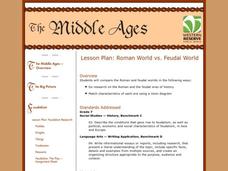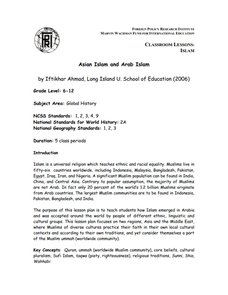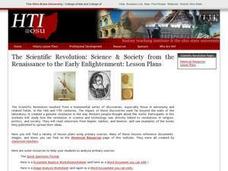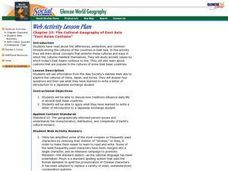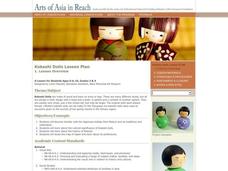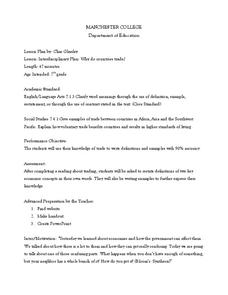Curated OER
East Asia Country Project
Get your young historians thinking about East Asian culture and history during this partner research project, in which they analyze a variety of East Asian aspects to prepare for a presentation. After an initial "what do we already know"...
Northeastern Educational Television of Ohio, Inc.
Roman World vs. Feudal World
Young historians compare the major features of the Roman and feudal worlds, such as religion, social hierarchy, and political tenets, using online resources and group discussion.
Curated OER
Social Studies: Lesson 2
Students explore the beginning of Communism. In this World History lesson, students exhibit their knowledge of Communism and the Marshall Plan through completion of a map activity.
Curated OER
Globalization: The Garment Industry in Southeast Asia
Students are introduced to the concept of globalization. In groups, they read primary source documents to view sweatshops from different points of view. They write a paper about the impact of globalization on the garment industry and...
Foreign Policy Research Institute
Asian Islam and Arab Islam
Focus on the impact and practice of Islam throughout Asia and the Middle East. Learners review the seven major religions, the spread of Islam, and Islamic tenets commonly practiced. They then research one country that practices Islamic...
Indiana Historical Society
Lesson One – Vietnam War Time Line
To prepare for an in-depth study of the Vietnam Era, class members research and create a timeline that tracks the United States' involvement in Southeast Asia and especially Vietnam.
Curated OER
The Scientific Revolution
Scientists participate in studying how new scientific advances have changed the world. They explain how astronomers have changed the way people view the universe, summarize the advances that were made in chemistry and medicine, and...
Curated OER
Geography and Culture of China
Take out a map, a paper, a ruler, and those coveted colored pencils for a lesson on Chinese culture and geography. This is a multifaceted approach to basic geography skills that incorporate story telling, class discussion, primary source...
Curated OER
Lost Names: Scenes From a Korean Boyhood,
What a great resource to share! Based on the book Lost Names by Richard Kim, this valuable lesson focuses on the Japanese occupation of Korea during WWII. Additionally, it employs first-person journaling as a mode of understanding themes...
Curated OER
Do the Tallywalker
Students study the basics of mapmaking, then make a tally walker, (geographic location device used in secret).
Institute for Geophysics
Understanding Maps of Earth
Here is your go-to student resource on primary geography concepts, including facts about the surface of the earth and its hemispheres, latitude and longitude, globes, types of maps, and identifying continents and oceans.
Curated OER
The Seven Continents Scavenger Hunt
Who doesn't enjoy an engaging scavenger hunt? Here, scholars listen to, and discuss, the informative text, Where is my Continent? by Robin Nelson. They then explore the seven continents and four major oceans using...
Curated OER
The Four Religions of East Asia
Pupils compare and contrast the four main religions of Asia (Buddhism
Confucianism, Daoism, and Shinto). This lesson is intended for use in the middle school Social Studies classroom.
Curated OER
Encountering Very Different Ways of Life
Students explore the concept of crossing cultures. They examine how Americans may be viewed by people in another culture and discover that that Peace Corps Volunteers are trained to cross cultures respectfully so that they are accepted...
Curated OER
Southeast Asia And Globalization
High schoolers investigate the area of Southeast Asia and how its economy has become the power that it is today. The concepts related to being a consumer are discussed. They go over how globalization has been introduced into Asia and...
Curated OER
The Cultural Geography of East Asia
Students use information from the Asia Society's AskAsia Web site to explore the cultures of China, Japan, and Korea. They answer four questions and then use what they have learned to write a letter of introduction to a Japanese exchange...
Curated OER
What's Integrity?
Students read a letter by Steve Williams to determine why self-discipline and integrity are important attributes for peace corps volunteers. They apply these concepts to their own lives.
Montana State University
One Mountain, Many Cultures
Americans may think of Mount Everest as a region dedicated to adventurous hikers, but many cultures have flourished there! Learners read informative books, watch videos, participate in classroom discussion, analyze folk tales, and...
Curated OER
Kokeshi Dolls
Students study the Japanese holiday Hina Matsuri and its traditions and celebration. They explore the history, location and cultural significance of Kokeshi dolls.
Curated OER
Why Do Countries Trade?
Seventh graders read about countries trading and then write definitions and examples of trading concepts they read about. For this trading lesson plan, 7th graders visit a website to read about trading.
Walters Art Museum
The Symbolism of Allegorical Art
Introduce learners to allegorical art with four bronze sculptures by Francesco Bertos. After modeling how to recognize bias and allegory in Bertos' Africa, class groups examine the other three sculptures in the series before creating...
Curated OER
China - the Geography of European Imperialism - Spheres of Influence in China
Ninth graders create a map of China. They identify the various spheres of influence carved out by the Imperialist powers of Europe as well as locating geographical features of china and major cities. They explain the global impact of...
Curated OER
Cultural Diversity In The Classroom
Young scholars engage in a lesson that supports the fact that Asian people are part of the educational culture in schools. The lesson includes background information for the teacher. With the completion of the unit students develop a...
Curated OER
COMPARING BUDDHISM AND CONFUCIANISM
Students conduct research into the two largest religions of Asia that are Buddhism and Confucianism. They set out to find the similarities and differences with the help of a graphic organizer.



